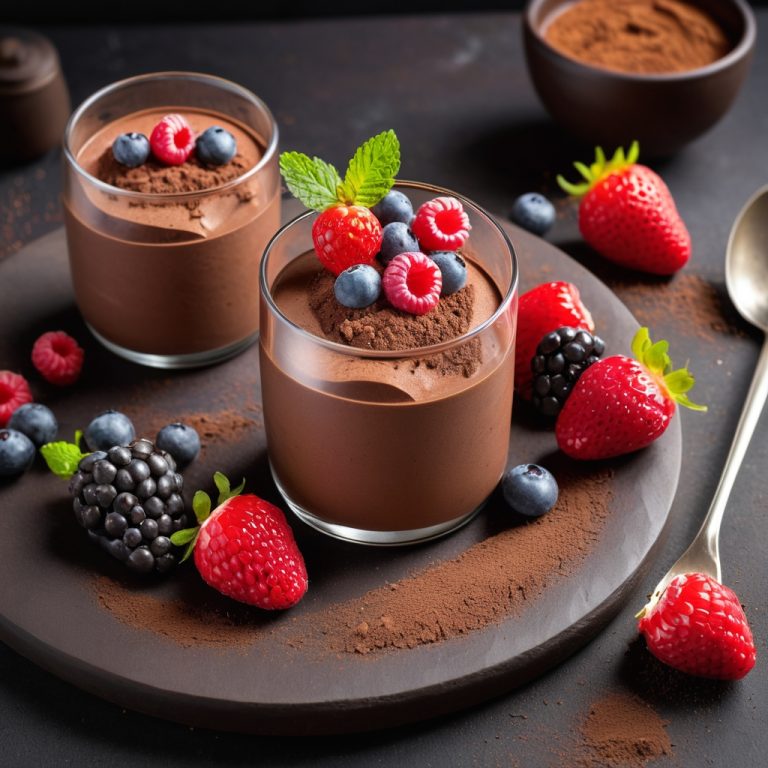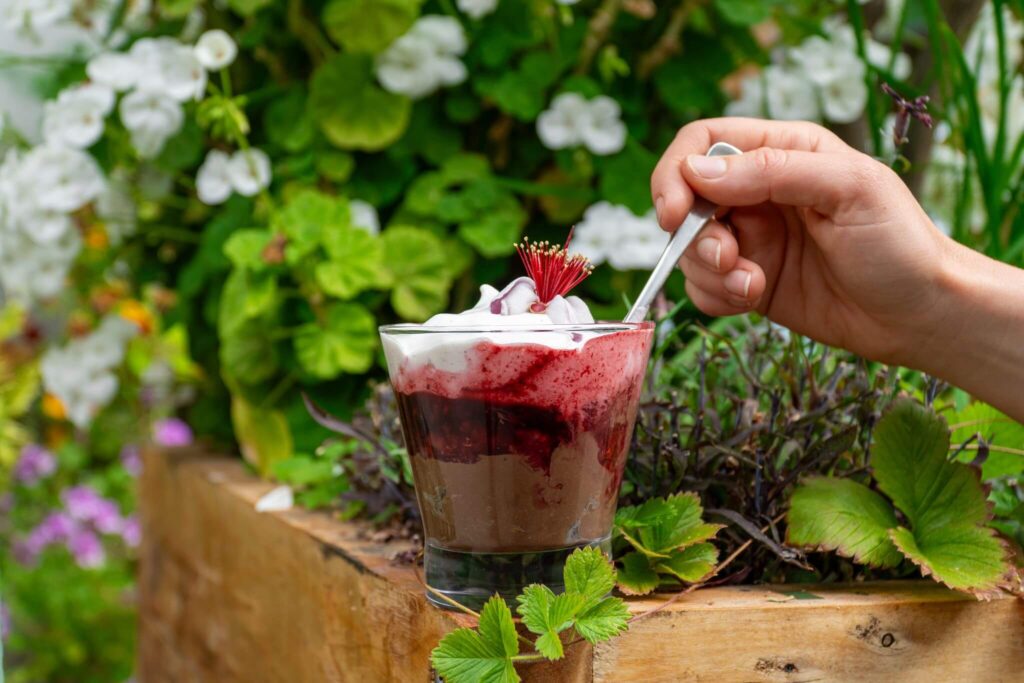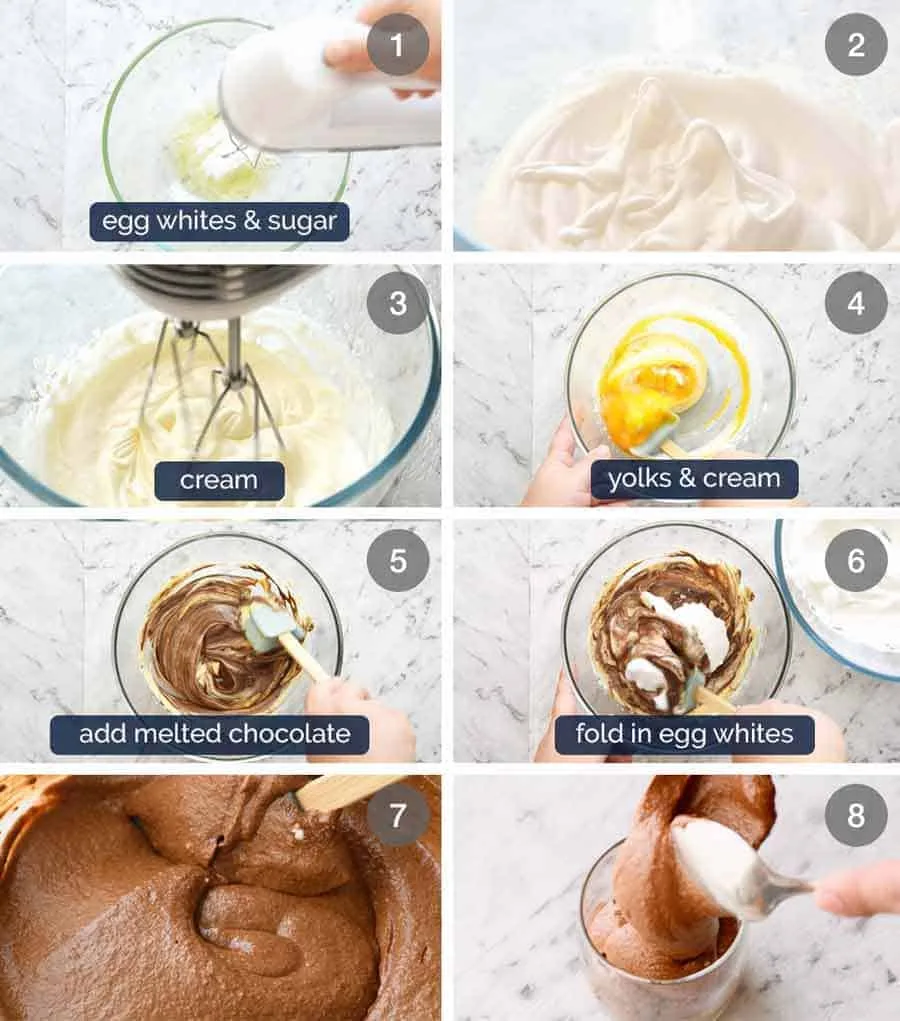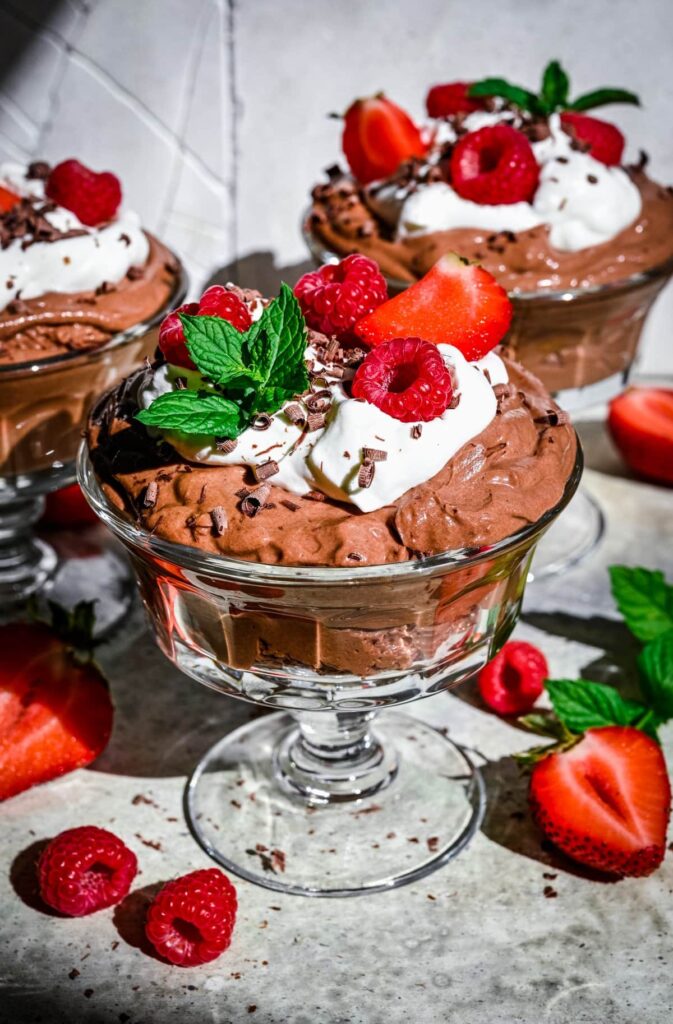INTRODUCTION ABOUT CHOCOLATE MOUSE
Chocolate mousse verrine is a delightful and elegant dessert served in individual glass cups, showcasing layers of rich, creamy chocolate mousse and complimentary textures or flavours. The term “verrine” comes from the French word “verre,” meaning glass, and refers to layered desserts or appetizers presented in a transparent container to highlight their visual appeal. This luxurious treat often combines smooth chocolate mousse with ingredients like whipped cream, biscuits crumbs, fruit compote, or ganache, offering a perfect balance of taste and texture. Ideal for parties and fine dining, chocolate mousse verrines are both indulgent and visually stunning, making them a favorite for chocolate lovers and gourmet dessert enthusiasts alike.

- Chocolate Mousse: Chocolate mousse is a light and airy French dessert with a foam-like consistency (“mousse” means foam in French), made by incorporating air into a chocolate base using elements like whipped cream, beaten egg whites, or other aerating ingredients. The earliest recipes for chocolate mousse date back to the 18th century.
- Layered Presentation: The beauty of a chocolate mousse verrine lies in its layered presentation. This allows for contrasting colors and textures, enhancing the visual appeal of the dessert and offering a delightful sensory experience with each spoonful.
- Flavor and Texture: Chocolate mousse verrines offer a harmonious blend of indulgence and texture, combining the heavenly creaminess of the chocolate mousse with optional contrasting elements like crunchy crumble, fresh fruits, or nutty ingredients.
- Versatility: You can customize chocolate mousse verrines by incorporating various ingredients to create diverse flavor profiles and textures. Some common variations include:
- Different Chocolates: Using dark, milk, or white chocolate, sometimes layered for a triple chocolate verrine.
- Fruits: Adding fresh fruits or fruit purées like raspberry, strawberry, or mango.
- Crunchy Elements: Including crumbled cookies, chocolate wafers, nuts, or streusel.
- Other Flavors: Incorporating coffee, caramel, or hazelnut spread.
- Serving Suggestions: Chocolate mousse verrines are often served chilled in individual glasses, making them elegant and portion-controlled desserts. They can be garnished with ingredients such as whipped cream, chocolate shavings, fresh fruit, or a dusting of cocoa powder. You can also experiment with toppings like strawberry sauce, mixed berry compote, or caramel sauce to enhance the flavor and elevate the presentation.
Conclusion
Chocolate mousse verrines combine the elegance of French pastry artistry with rich chocolate indulgence. Their versatility, visual appeal, and customizable nature make them a favorite among home bakers and professional chefs alike. Whether simple or elaborate, this dessert is sure to impress both visually and taste-wise.

Chocolate Mousse Verrine Recipe
Servings: 6 verrines
Prep Time: 30 minutes
Ingredients Table
| Component | Ingredient | Quantity |
|---|---|---|
| Chocolate Mousse | Dark chocolate (60–70%) | 150 g |
| Heavy cream (chilled) | 300 ml | |
| Sugar (optional) | 1–2 tbsp | |
| Crust Layer | Chocolate cookies (crushed) | 100 g |
| Melted butter | 30 g | |
| Garnish | Whipped cream | As needed |
| Chocolate shavings/cocoa | As desired | |
| Berries or mint (optional) | For decoration |
Instructions
Prepare the Crust
- Crush cookies into fine crumbs using a food processor or rolling pin.
- Mix crumbs with melted butter until combined.
- Spoon about 1 tablespoon into the base of each verrine glass and press gently to form a layer.
- Chill in the fridge while preparing the mousse.
Make the Chocolate Mousse
- Melt chocolate in a double boiler or microwave. Let it cool slightly.
- In a separate bowl, whip the heavy cream until soft peaks form. Add sugar if desired.
- Gently fold the melted chocolate into the whipped cream in batches, maintaining the airy texture.
Assemble the Verrines
- Spoon or pipe the mousse over the crust layer in each glass.
- Smooth the tops with a spoon or spatula.
- Chill for at least 2 hours (or until set).
Garnish and Serve
- Top with whipped cream, chocolate shavings, or berries.
- Serve chilled with a small spoon and enjoy.

Typical Nutritional Advice(per 100g serving)
| Nutrient | Amount (approx.) |
|---|---|
| Calories | 250–350 kcal |
| Total Fat | 20–25 g |
| Saturated Fat | 12–15 g |
| Sugar | 20–30 g |
| Protein | 3–5 g |
| Carbohydrates | 25–35 g |
| Fiber | 1–2 g |
| Calcium | 50–80 mg |
Health Tips and Modifications
1. Portion Control:
Stick to small verrine glasses (about 100 ml) to keep portions reasonable while still satisfying your sweet tooth.
2. Use Dark Chocolate:
Opt for dark chocolate (70% cocoa or higher). It has less sugar and more antioxidants compared to milk chocolate.
3. Lighten the Cream:
Use whipped Greek yogurt or low-fat cream instead of heavy cream to cut saturated fat.
4. Reduce Sugar:
Use natural sweeteners like honey, maple syrup, or a sugar substitute like stevia in moderation.
5. Add Fruit:
Incorporate fresh berries or a fruit compote for natural sweetness and added fiber, vitamins, and antioxidants.
6. Include Whole Grains:
If using cookie or cake layers, choose options with whole grains or oats to boost fiber.
7. Watch the Layers:
Keep calorie-dense layers thin. Emphasize lighter, airy mousse and fruit layers over dense chocolate or biscuit layers.
Healthier Version Ideas
- Greek Yogurt Chocolate Mousse with raspberry purée
- Avocado Chocolate Mousse for a dairy-free, heart-healthy version
- Tofu-Based Mousse for added protein and low fat
Who Should Be Cautious?
- Diabetics: Due to high sugar content
- Those with heart disease or high cholesterol: Due to saturated fat
- Lactose intolerant individuals: Unless using dairy-free alternatives
What are the benefits of mousse?
While it’s often used to help define waves and curls, mousse can be a helpful styling aid for fine, straight hair, too. Used properly, it can help make flat hair appear fuller and thicker, with plenty of bounce, body, and movement. Some formulas may boast additional benefits, too.
What is interesting about chocolate mousse?
Chocolate mousse, besides being delectable, also has a fascinating history. It was first known as “mayonnaise de chocolat” – and, even more interesting, was invented by world-renowned French post-Impressionist painter Henri Toulouse-Lautrec, in the late 19th century.

Types of Chocolate Used
Depending on the recipe or preference, chocolate mousse verrines can use:
- Dark chocolate for an intense, rich flavor
- Milk chocolate for a sweeter, creamier taste
- White chocolate for a unique, sweet and buttery flavor
Some recipes even use flavored chocolate (like mint or orange-infused) for added creativity.
Texture and Flavor
The success of a good verrine lies in balancing:
- Creaminess (from the mousse or cream)
- Crunchiness (from biscuit layers or nuts)
- Tanginess or freshness (from fruits)
- Sweetness vs. bitterness (dark chocolate and mild cream)


